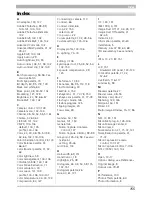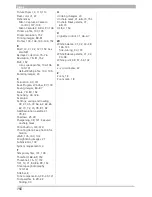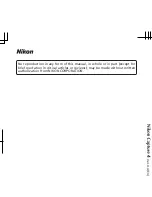
150
Appendix E
Compression
A method for reducing fi le sizes for storage or transmission. Compression algorithms can be
divided into “lossless” algorithms, such as LZW, in which no information is lost when fi les are
restored to their original size for display or editing, and “lossy” algorithms, such as JPEG, in
which some information is lost when the fi le is restored.
See also
JPEG, TIFF.
Crop
The portion of the image selected in an image window.
Curve
See
Tone Curve.
Eyedropper
A tool for sampling white point, black point, or midpoint.
See also
Black point, Midpoint,
White point.
FireWire
Apple’s term for the IEEE 1394 interface.
See
IEEE 1394.
Fisheye lens
A “fi sheye” lens is any lens with a view angle of 180 degrees or more. Fisheye lenses may have
a view angle of 180 degrees in all directions or only diagonally. Distortion increases towards
the edges of the picture, with little or no distortion at the center of the image. The Fisheye
Lens palette in Nikon Capture 4 can be used to reduce distortion in images taken with an AF
DX Nikkor ED 10.5 mm f/2.8G lens to create an image close to what would be produced by
an ordinary wide-angle lens.
Gamma
Gamma (also written “
γ
”), a fundamental property of video systems, determines the intensity
of the output signal relative to the input. When calculating gamma, the maximum possible
input intensity is assigned a value of one, and the minimum possible intensity (no input) is
assigned a value of zero. Output is calculated by raising input to the inverse of the gamma
value (output = input
( 1/
γ
)
).
Gamut
The range of colors that can be expressed by a given input device (for example, scanner or
digital camera), output device (monitor or printer), or color profi le. No gamut can reproduce
all of the colors seen by the human eye. The gamut of primary RGB (
R
ed,
G
reen, and
B
lue)
transmitted light displays (fi lm transparencies and color monitors) is very different from, and
complementary to, the gamut of secondary CMYK (
C
yan,
M
agenta,
Y
ellow, and blac
K
) re-
fl ect ed light displays (printed materials).
See also
CMYK, Profi le, RGB.
Gray point
See
Midpoint.
Halo width
The extent of pixels around a selected central pixel affected when Unsharp Mask is applied.
Also referred to as “radius.” Increasing the halo width increases the width of edges affected
by Unsharp Mask. Excessive application of Unsharp Mask results in an undesirable halo along
edges in the image.
See also
Unsharp Mask.
Summary of Contents for 4DIF
Page 1: ...En Ver 4 4 En Ver 4 4 ...
Page 10: ...6 ...








































